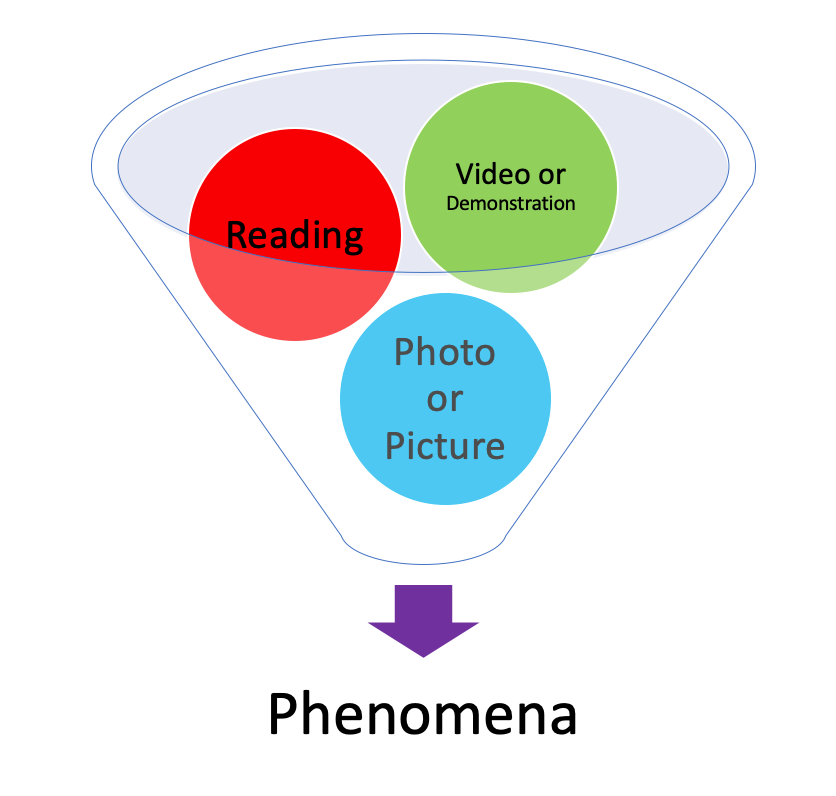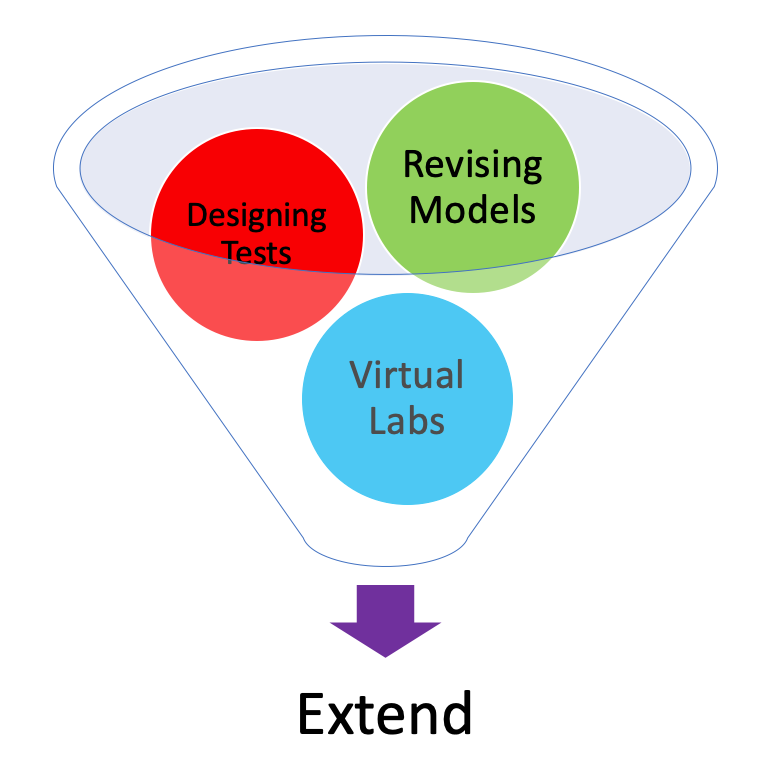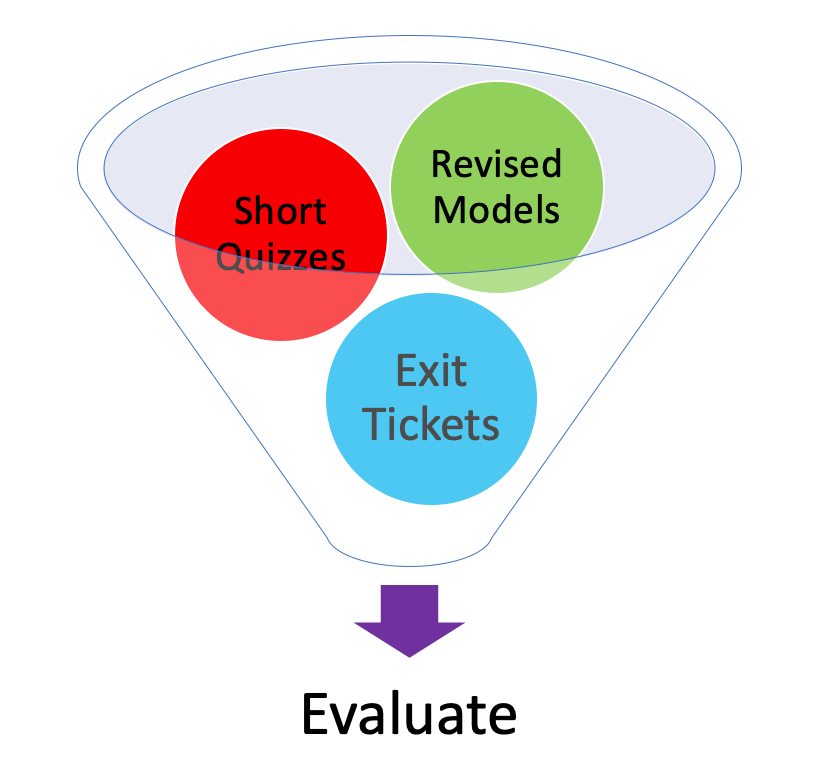In our 2nd post about virtual science teaching, we provide a roadmap for teachers to ensure all students engage with rigor and relevance throughout the sessions. We also provide you with links to several resources.

Keep It Phenomenal!
A good science lesson always begins with phenomena. It can be a short video, a photo, a picture, a demonstration, or a reading. As the saying goes, “Phenomena doesn’t have to be phenomenal.” Do make it thought-provoking.
Thinking routines around phenomena often last much longer in distance learning, so keep that in mind as you plan.
Tips To Promote Sense-making
Post the phenomena and ask students to write what they noticed and what they think. Let them work with a partner, a sibling, or a parent to discuss the phenomena. Prepare questions in advance and post them for a guideline. Students can post their writing for feedback in the form of a couple of sentences of encouragement or questions. At the next meeting, have students meet in small groups or as a class to discuss the phenomena. Have each student reply to at least one classmate.
Ask students to write any new ideas or questions to post on the Driving Question Board for later research. In addition to posting questions and notices, encourage students to develop models, revising them as they discover more about the subject. Remember, models reveal student thinking!
Our last post- https://thepracticalscienceteachers.com/virtual-learning-in-science-tips-and-ideas-for-setting-up-your-online-class-part-1/ – provided teachers with some examples of tools for use in a virtual science classroom. Go back and review some of our suggestions.
Daily Do’s
Not sure where to start? NSTA offers free Daily Do’s, lessons aligned to NGSS standards. Daily Do’s are a group of over 50 investigations providing relevant tasks. Daily Do’s cover elementary, middle, and high school grades. These lessons are perfect for online science learning. Check it out at https://www.nsta.org/resources/daily-do.

Exploring
Once students engage with the phenomena, it’s time to get them exploring! How can teachers ensure the engagement is strong via screen time? Again, it takes some planning. Be specific about what you want students to learn in the lesson. Will you use the district’s science curriculum resources or create streamlined versions? If you use videos in your classes, make screenshots of the relevant parts to send home to students who don’t have access to technology.
Safety First!
Because we’re science teachers, we know a great lab experience is invaluable, but we must keep safety guidelines like those supported by the NSTA at the forefront of online experiences. Pay particular attention to liabilities because you will be liable for any injuries that happen during lab assignments!
Keep It Active
Liabilities aside, the worst way to implement online learning in science is to assign readings, worksheets, or fill in the blank pages. Students need to be curious! How can that be accomplished online? Demonstrate activities on your LMS and ask open-ended questions. Use a visual aid such as a steaming pot of water. Virtual labs are also a fabulous tool to use with your students. Ask students what they may have observed at home around the concept.
Why? Why? Why?

I often tell my students I’m their parents’ revenge because I constantly ask why questions to draw out explanations. Ask what they notice or how one event demonstrates the concept. Can they describe the concept another way? What do they notice? What are their questions? Those questions are invaluable because students who question are thinking. Encourage students to write their questions on a Driving Question Board and review them often. What can they answer now? What new questions do they have?
Once students have questions to explore, ask them to design an investigation to answer the question. The designs must be uploaded so they can be discussed in collaborative groups. While you may not assign students to perform their tests, many will do it on their own. That’s great! It adds to discussions and spurs new questions.
Models
Modeling is crucial to virtual learning. Your students should be creating models as part of a lesson or unit. Ask them to continually revise the same model by adding new understandings and questions. However, pay close attention to misunderstandings and clear them up as soon as possible. Much like face-to-face schooling, students need to be provided with feedback continually.
3-D Lessons
Don’t forget to utilize the all-important DCI’s, SEP’s, and CCC’s in lessons. Consult them frequently to determine which practices may be missing in a lesson or unit and insert ones that make sense.
Evaluate

Assessing students in online classes is a hot topic. Some districts want students evaluated while some are more lenient. Whether a district asks for assessments to be completed or not, science teachers are on the lookout for misconceptions. That’s where formative assessments like the evolution of student models or asking students to answer questions online come into play. What do we want students to take away from each lesson? Develop a targeted question or two for students to answer. Use Google Forms to create short quizzes. The completed models can also be used for an assessment.
Beware! Hazards Ahead!

Online learning in science is new. We’re learning on the fly. Be sure you don’t fall down a few rabbit holes along the way. Many students are feeling isolated right now, but here are a few solutions to help. Schedule one on one meetings with students. Call students who don’t have access to technology.
Even with the best technology, we often get a little frantic about covering the curriculum. To say this school year is odd is an understatement! Spend less time worrying about “getting through” every part of the curriculum. Strip it down to the most necessary elements. Use as few worksheets as possible and eschew vocabulary sheets. Instead, use new words in context.
I don’t know about you, but the one-size-fits-all clothing never does fit me. Use that image when working with your students. Try to meet each child’s needs as much as possible. Talk to your parents. Keep the line of communication open.
Finally:
Just as important as looking after your students’ needs, don’t forget your own needs. It’s no mystery the 2020-21 school year will be a challenge. A few adaptations, including models in student work and encouraging student questions will help keep the rigor and relevance in your science teaching.

Hi,
I hope you are in good health. I am a passionate reader and writer as well.
I am writing you to present an offer that can benefit both of us.
I want to publish a guest post article on your website and will send you some topic ideas for that.
The article however, will be of great quality and is free of cost. If my ideas interest you, I would send the article on the selected topic idea chosen by you. I would just need you to provide me a backlink within the main article.
Please get back with your kind response to this offer.
I look forward to your prompt response.
Have a great day!
Regards.
Ashlie Lopez
This isn’t a prompt response, but we would need to know what you want to write about and a rough draft.